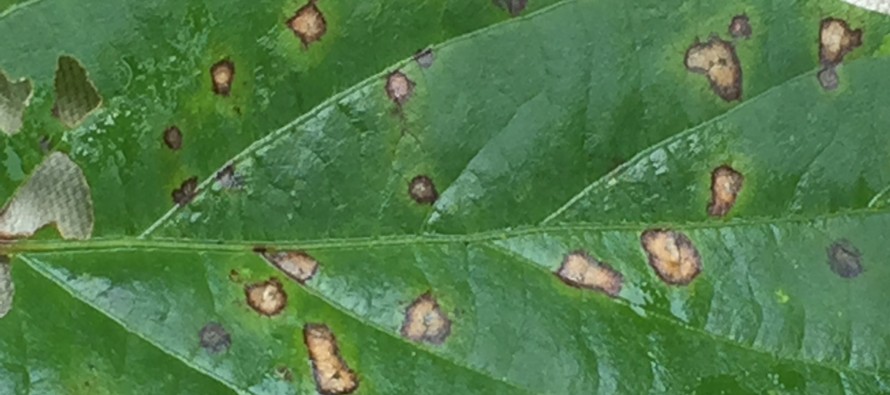2015 Frogeye Leaf Spot Fungicide Evaluations

Related Articles
- 2010 Soybean And Corn Variety Trial Data 3
- Rice Variety Trial Results For 2010, Plus Rice Research Report 0
- Evaluation of Peanut Prescription Rx Program in Mississippi 0
Latest Tweets

Frogeye leaf spot continues to be a common disease in the MS soybean production system. When susceptible varieties are planted, fungicides are one of the best methods of managing the disease.
Numerous trials were conducted during the 2015 season to determine the efficacy of multiple products and product combinations on frogeye leaf spot of soybean in a FLS-susceptible variety.
Fungicide trials were conducted in Stoneville, MS using a frogeye leaf spot susceptible variety (Dyna-Gro 37Ry47). Fungicide applications were made at numerous timings. Plots were all 13.3 ft wide (40 inch centers) and 30 feet in length. Soybean was planted at a rate of 11 seed per foot. Plots were rated prior to fungicide application to determine the baseline disease present and multiple times post-application. In addition to a frogeye leaf spot rating (0-9 scale), the presence of phytotoxicity (0-100%) as well as Cercospora blight (0-9 scale) and green stem severity (0-100%) were assessed prior to harvest. Keep in mind that not ALL of the products are labeled for application in soybean. Products without a current label are highlighted in the tables and were not deleted so as not to change the statistical data supporting each table. In addition, the information for each experimental product evaluated in specific trials remains in the table, but the rate information was deleted. Some specific combinations of products were included in trials conducted during 2015 based on questions asked during the winter. For example, several people inquired as to whether or not fungicide resistance within the frogeye leaf spot fungal population existed. More than one individual suggested that by adding a foliar nutrient product that the strobilurin fungicide would be “reactivated” and provide better control of the frogeye leaf spot fungus. Some sequential applications were made in specific trials and there are a few fungicide + insecticide combinations since a strobilurin + Dimilin is a common application practice in MS and numerous people have asked if Dimilin is effective on frogeye leaf spot.
Since some generic products are available and at present farmers could choose to make their own multi-mode of action fungicide (either a 2 or 3-way combination) several different product combinations were made in an attempt to increase efficacy against FLS. A summary table is included to highlight the specific product or product combinations that were assessed during the 2015 season. However, some sequential product combinations (R3 followed by R5) applications were made, but the sequential applications are not included in the summary table.

Summary table of fungicide trial products and combinations. Rates and timings are also included as well as mode of action of each component.
The tables listed below include disease ratings, green stem evaluations, phytotoxicity observations, yield, and statistical comparisons for each trial conducted. The trials conducted were sponsored by: BASF, Bayer, Cheminova, Gowan, Sipcam, and Arysta LifeSciences.
Table 1 – R3 comparisons (Table 1)
Table 2 – R3 comparisons (Table 2)
Table 3 – R3 comparisons (Table 3)
Table 4 – R5 comparisons (Table 4)
Table 5 – R3 and R5 comparisons (Table 5)
Table 6 – V5, R1, R3 sequentials (Table 6)
Table 7 – R2, R3 and sequentials (Table 7)
Table 8 – R2, R3 (Table 8)
Table 9 – R3 comparisons (Table 9)
Table 10 – R3 comparisons (Table 10)




Let me tell You a sad story ! There are no comments yet, but You can be first one to comment this article.
Write a comment